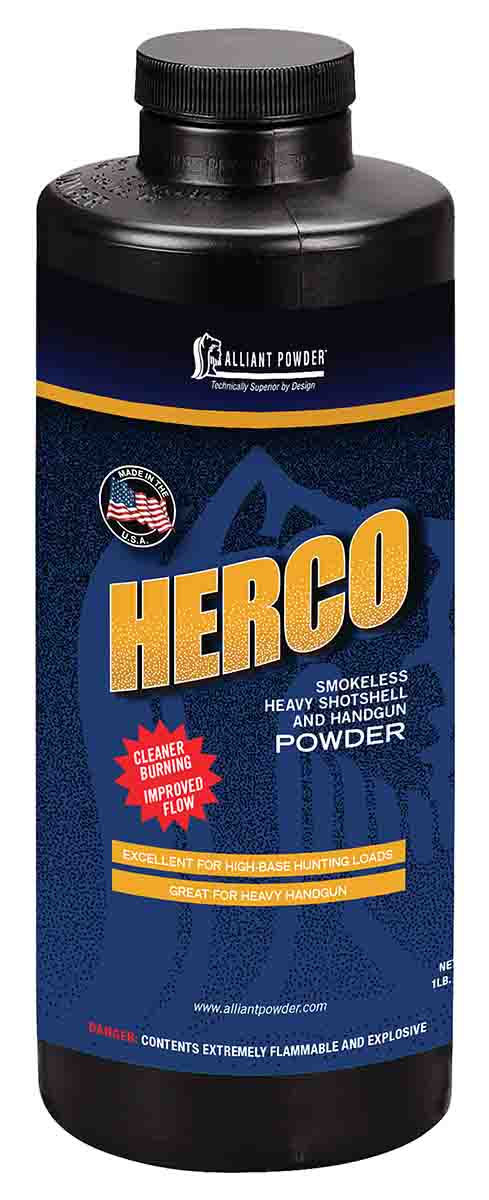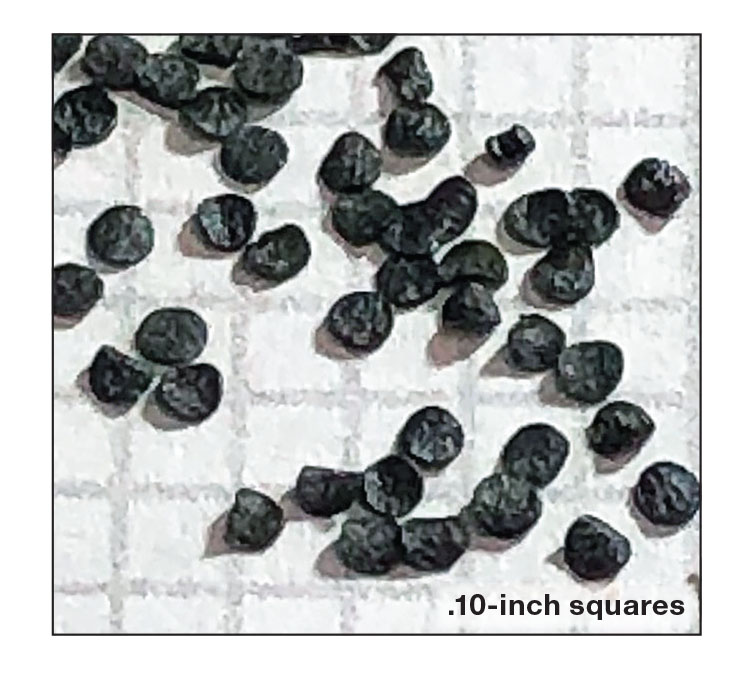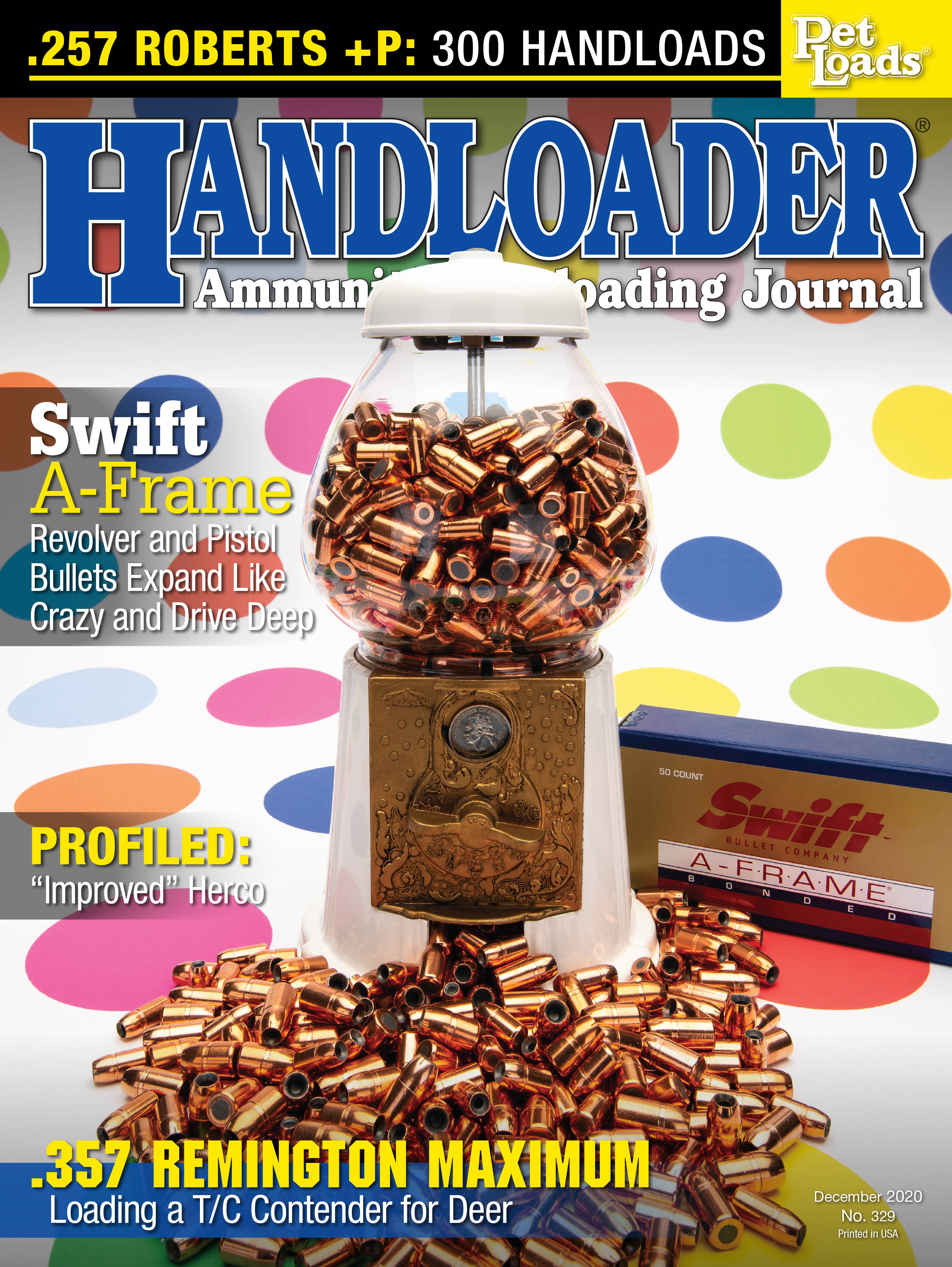Propellant Profiles
"Improved" Alliant Herco
column By: Randy Bimson | December, 20

Introduced to the ammunition manufacturing industry in 1920, it was the mid-1930s when Herco was first made available as a canister powder for the handloader. Herco has been hailed for years as one of the best propellants for hunting loads in 2¾-inch 12-, 16-, 20- and 28-gauge shotshells. Herco also has a long-standing reputation for being one of the dirtier burning propellants. Leaving a lot of residue is not so much of an
issue with break-open and pump-action shotguns but can be the cause for some consternation for hunters whose Herco loads are a constant source of fodder for their autoloading shotguns.
Early in 2020, Alliant Powders announced the availability of an “improved” Herco, with promises of a much cleaner burning powder and enhanced metering (flow) characteristics.
So, what has changed with the new Herco? The formulation has not changed, Herco is still a double-base propellant with a 20 percent nitroglycerin content. The physical characteristics remain the same as well. The dark gray extruded flakes measure roughly .062 inch in diameter and .006 inch in thickness. The bulk density is a nominal .58g/cm3. The improvements are not a result of chemical formulation changes, but rather of continuous proprietary process improvements made at the New River Energetics powder plant located in Radford, Virginia, where Herco is produced. They are similar to the improvements that have allowed updates to Red Dot, Green Dot and Unique over the last 20 years.
In addition to improving the performance of Herco, there was one very important factor that Alliant was able to achieve that will endear Alliant to long-time Herco users. Loading data for the improved Herco does not change. You use the same charge weights and powder bushings as in the past. Nice!
I cut my shotshell-loading teeth on a Ponsness-Warren 375 Du-O-Matic loader that I still load all my field loads on to this day. The Ponsness-Warren made quick work of assembling the classic 2¾-inch, 12-gauge upland field load of 1¼ ounces of hard shot – No. 6 for Hungarian partridge and sharptail grouse and No. 5 for late season pheasants – propelled by then-Hercules Herco powder. With a published velocity of 1,300 feet per second and fired from a sweet 1960s vintage Simson double trigger, sidelock side-by-side, this shotshell/shotgun combination attributed to what many of my hunting cohorts consider the highpoint of my upland gamebird hunting ability.
When pheasant hunting became a passion, the Simson was replaced by a lively and easy-carrying 6-pound 12-gauge Browning Superposed Superlight. The Ponsness-Warren 375 Du-O-Matic was then tasked with turning Winchester AA cases, Winchester WAA12R one-piece plastic wads, a copious quantity of W-571/Hodgdon HS-7 powder and 13⁄8 ounces of plated No. 5 shot into the ultimate pheasant slayer. At a published velocity of 1,330 feet per second, in the light Browning Superlight it did a number on both ends. I eventually came to my senses and realized the pheasants were no harder to drop from the sky today than they were in my younger days.
With the realization neither my Superposed Superlight nor I needed to be hammered by those stiff 13⁄8 ounce loads, I found a renewed love for Herco. While today’s plastic cases, one-piece wads and newer, slower burning powders may have overshadowed the versatility of Herco somewhat, it remains a resplendent propellant for assembling the classic upland and early duck season “heavy field” loads: 1¼-ounce, 2¾-inch 12-gauge; 11⁄8-ounce, 2¾-inch, 16 gauge; 7⁄8 and 1-ounce 20 gauge; and possibly the darling of them all, the ¾-ounce 28-gauge load.

My go-to 2¾-inch 12-gauge field load calls for a Remington STS hull, 1¼ ounces of Lawrence Magnum lead shot (4/5 percent antimony), Remington SP12 wad and 26 grains of Herco ignited by a Winchester 209 primer. This recipe generates a published muzzle velocity of 1,275 feet per second and produces exceptionally uniform patterns from a Superlight, Beretta 682 and Beretta 390.
A Briley Companion 28-gauge tube set was purchased for the aforementioned Superlight. With the tubes, it weighs in at 6 pounds, 12 ounces, just enough to make it swing a little smoother. With Remington 28-gauge STS hulls loaded with 14 grains of Herco, ¾ ounce of shot, a Remington PT28 wad and a Remington 209 primer, it is a delight to shoot with recoil that is best described as negligible.
To validate Alliant’s claims of the latest rendition of Herco being cleaner burning and having improved flow characteristics, I loaded 100 rounds of the above listed 12-gauge recipe and 50 rounds of 28 gauge with a recent lot of Herco. For comparison purposes, the same quantity of 12- and 28-gauge hulls were loaded using the same recipe and pre-2020 Herco from a 4-pound canister I purchased in 2017.
Flow characteristics were gauged utilizing the Ponsness-Warren as representative of a shotshell loader, and a RCBS Uniflow powder measure as a pistol shooter might use to load handgun cartridges. To create a “worst case” scenario, I removed the optional powder baffles from the Ponsness-Warren and RCBS Uniflow powder hoppers. One hundred charges of each Herco type were dispensed by both methods. All thrown charges were weighed on a “tuned” RCBS 10-10 mechanical beam scale.
Using new Herco and a Ponsness-Warren “O” powder bushing listed as throwing a charge weight of 26.0 grains, the “improved” Herco showed an extreme spread of 0.4 grains for 100 charges and the pre-2020 Herco an extreme spread of 0.6 grains. For whatever reason, which I could not put a finger on, I noticed a difference in how smoothly the Ponsness-Warren charging ring, without shot to influence the test, moved from the powder hopper to the powder drop-tube position. The pre-2020 Herco would occasionally cause the charging ring to hang-up and become stiffer to move while the new Herco showed no such tendency throughout the test. Given that the physical size and shape of Herco has not changed, it seems somewhat of a strange phenomenon being that it is a mechanical interference issue. Whatever the reason, I will take “improved” Herco’s performance.
The RCBS Uniflow, set to throw an average charge of 17 grains, produced an extreme spread of 0.1 grains with new Herco and 0.2 grains with pre-2020 powders. Pre-2020 Herco would occasionally cause the Uniflow charging handle to become noticeably harder to move for one or two throws. Subjective a test as it may be, my improved Herco meters better.
To get a comparative idea of how clean the two Herco powders burn in relation to each other, I shot 100 rounds of trap with each of the 12-gauge loads using my Beretta 390 and 50 rounds of skeet with each of the 28-gauge loads using the Briley-tubed Browning Superlight.
The improved Herco left the Beretta 390 barrel and Briley tubes with noticeably less residue in the barrel. Hunters who favor auto-loading shotguns will appreciate improved Herco. Unlike the pre-2020 Herco, it left virtually no powder residue in the action area. Powder residue buildup in the action area is one of the main culprits that will put a hard-hunted and seldom cleaned autoloader out of the action. Improved Herco wins hands down on being a much cleaner burning propellant.
While most handloaders think of Herco exclusively as a shotshell powder, loaddata.com lists a vast spectrum of loads for handgun cartridges, from the diminutive .25 Auto through the .45 Colt, and rifle cartridge cast bullet loads. That however is a discussion best left for a future column.
American made and available in one-, 4- and 8-pound canisters, Herco is a powder that I recommend every handloader who loads shotshells, handgun and cast bullet rifle loads have in their propellant inventory.


